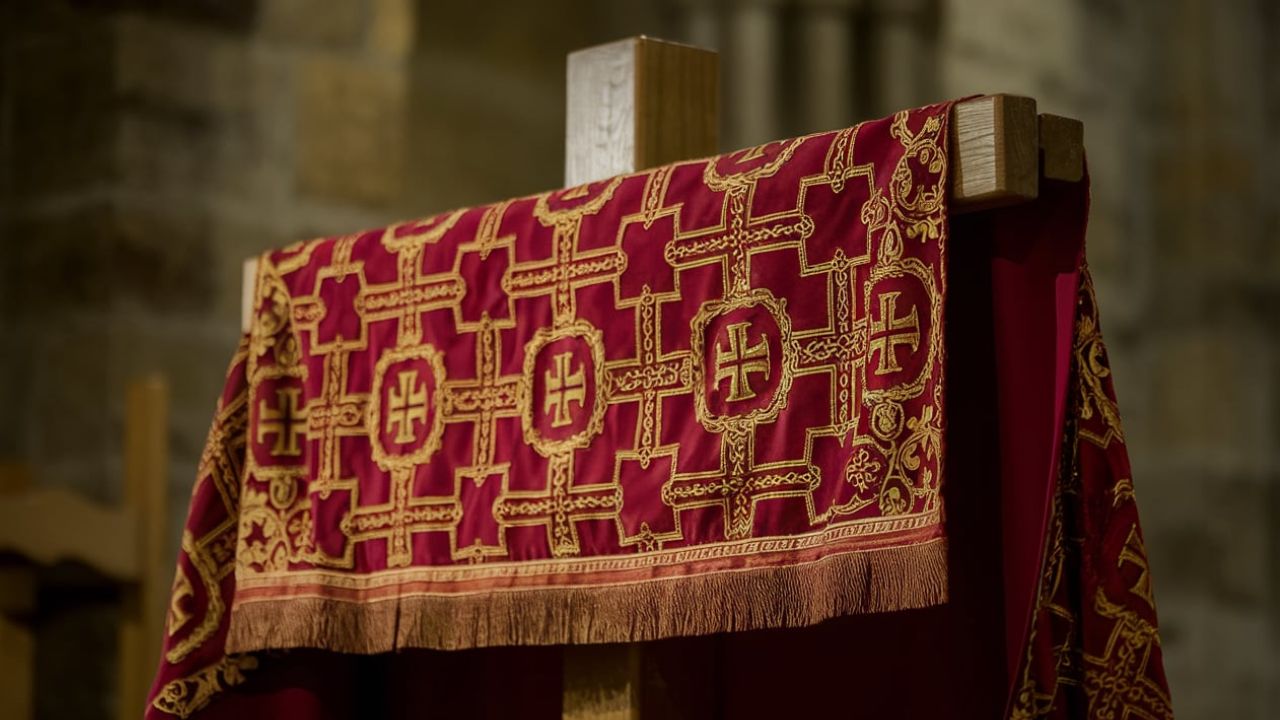
Liturgical Fabrics
Introduction
Liturgical fabrics play an essential role in religious ceremonies, symbolizing faith, tradition, and devotion. These sacred textiles adorn church interiors, clergy vestments, and altar linens. Worship spaces use richly woven fabrics to reflect spiritual themes and enhance the atmosphere of reverence.
Throughout history, churches have chosen specific materials, colors, and embroidery styles for different seasons and rituals. These choices reflect theological significance and historical continuity. The beauty of liturgical fabrics serves as a visual representation of faith, dignity, and worship. Understanding their importance helps believers appreciate the deeper meanings behind religious garments and church decorations.
Table of Contents
- The Meaning and Significance of Liturgical Fabrics
- The History of Sacred Textiles in Religious Worship
- Common Materials Used in Liturgical Fabrics
- The Role of Colors in Liturgical Fabrics
- Traditional Embroidery and Symbolism in Church Vestments
- The Use of Liturgical Fabrics in Clergy Vestments
- Altar Linens and Their Spiritual Importance
- The Impact of Liturgical Fabrics on Worship Spaces
- How Different Christian Denominations Use Sacred Textiles
- Seasonal Changes in Liturgical Fabrics and Their Meanings
- Modern Innovations in Liturgical Textiles
- The Influence of Culture on Ecclesiastical Fabrics
- How to Care for and Preserve Liturgical Fabrics
- The Role of Artisans and Designers in Creating Sacred Textiles
- FAQs
The Meaning and Significance of Liturgical Fabrics
Liturgical fabrics hold deep spiritual significance in religious traditions. These sacred textiles contribute to the beauty and solemnity of worship. Every fabric, embroidery pattern, and color choice carries a meaning tied to theological principles.
Churches use fine fabrics to express devotion, dignity, and the sacred nature of religious rites. Luxurious materials symbolize purity, reverence, and the divine presence. Every vestment and altar cloth enhances the worship experience by creating a sense of solemnity and holiness.
The History of Sacred Textiles in Religious Worship
Liturgical fabrics date back to ancient times when early Christians adapted Roman and Byzantine garments for worship. Wealthy donors commissioned elaborate vestments and altar cloths to honor God. Over centuries, religious orders developed distinct traditions regarding textiles.
Medieval churches imported silk, gold-threaded brocades, and embroidered linen for ecclesiastical use. Renaissance artists contributed intricate designs that blended sacred iconography with elaborate patterns. Modern churches continue these traditions, incorporating historical influences into contemporary liturgical textiles.
Common Materials Used in Liturgical Fabrics
Churches use high-quality fabrics to reflect the sanctity of worship. Some of the most common materials include:
- Silk – Symbolizes purity, elegance, and divine majesty.
- Linen – Represents humility and service, commonly used for altar cloths.
- Velvet – Enhances visual richness in ceremonial vestments.
- Brocade – Features intricate woven patterns that symbolize faith.
- Gold and Silver Threads – Add spiritual symbolism and honor to church textiles.
These materials ensure durability, beauty, and a connection to centuries of worship tradition.
The Role of Colors in Liturgical Fabrics
Colors in liturgical fabrics convey theological meanings. Each season and celebration features specific shades that align with religious themes.
- White – Represents purity, joy, and resurrection, used during Easter and Christmas.
- Red – Symbolizes the Holy Spirit, martyrdom, and Pentecost.
- Purple – Denotes penitence and preparation during Advent and Lent.
- Green – Reflects growth, hope, and ordinary time in the church calendar.
- Gold – Used for special feasts and high celebrations, symbolizing divine glory.
Understanding these colors helps worshippers connect with the rhythm of the liturgical year.
Traditional Embroidery and Symbolism in Church Vestments
Embroidery on liturgical fabrics features Christian symbols that carry deep meanings. Skilled artisans handcraft intricate patterns, often using gold and silver threads.
- Crosses – Represent Christ’s sacrifice and victory over sin.
- Lamb of God – Symbolizes Jesus as the ultimate sacrifice.
- Alpha and Omega – Signify God’s eternal presence.
- Wheat and Grapes – Represent the Eucharist and Christ’s body and blood.
These symbols enrich vestments, making them visually and spiritually significant.
The Use of Liturgical Fabrics in Clergy Vestments
Clergy vestments showcase liturgical in various garments worn during worship. Each piece carries historical and theological importance.
- Chasubles – Outer garments worn by priests during Mass.
- Stoles – Long, narrow strips of fabric draped around the neck.
- Copes – Ornate capes worn during processions.
- Albs – White robes symbolizing purity.
Liturgical enhance these vestments, emphasizing the sacred role of clergy in worship.
Altar Linens and Their Spiritual Importance
Altar linens serve practical and symbolic purposes. These sacred cloths ensure the dignity of the altar and Eucharistic celebration.
- Corporal – Holds the Eucharistic elements during Mass.
- Purificator – Cleans the chalice after communion.
- Altar Cloth – Covers the altar as a sign of reverence.
- Pall – Protects the chalice and hosts from contamination.
Churches select high-quality fabrics to maintain the purity and sanctity of these sacred linens.
The Impact of Liturgical Fabrics on Worship Spaces
Liturgical transform worship spaces into sacred environments. Richly decorated textiles add reverence, solemnity, and visual beauty to church interiors.
Large banners, embroidered hangings, and altar coverings create an atmosphere that enhances prayer and reflection. The presence of sacred textiles connects worshippers to centuries of Christian tradition.
How Different Christian Denominations Use Sacred Textiles
Various Christian traditions use liturgical differently. Catholic, Orthodox, Anglican, and Protestant churches incorporate sacred textiles into worship in unique ways.
- Catholic Church – Uses elaborate vestments and richly embroidered fabrics.
- Eastern Orthodox Church – Features ornate, gold-threaded robes and decorative icon veils.
- Anglican Church – Blends traditional vestments with modern liturgical textile designs.
- Protestant Churches – Some use simple vestments, while others embrace colorful altar hangings.
Understanding these differences highlights the diverse expressions of Christian worship.
FAQs
1. Why are liturgical fabrics important in worship?
Liturgical fabrics enhance the sacredness of ceremonies, symbolize faith, and create a reverent atmosphere in worship spaces.
2. What materials are commonly used for church vestments?
Churches use silk, linen, brocade, velvet, and gold-threaded textiles for vestments and altar cloths.
3. How do liturgical colors change throughout the year?
Churches follow a liturgical calendar, using different colors for specific seasons and religious celebrations.
4. What symbols appear on liturgical?
Christian symbols such as crosses, wheat, grapes, and the Alpha and Omega frequently decorate sacred textiles.
5. How should liturgical fabrics be cared for?
Churches preserve fabrics by using proper storage, gentle washing, and regular maintenance to prevent damage.
Conclusion
Liturgical fabrics reflect the beauty, tradition, and sacredness of Christian worship. These sacred textiles connect believers to centuries of faith, enriching the worship experience through color, symbolism, and craftsmanship. Understanding their significance deepens appreciation for their role in religious ceremonies.







